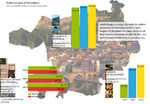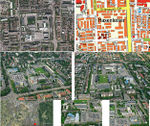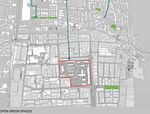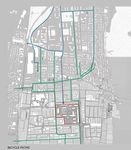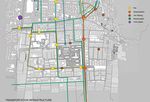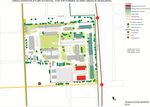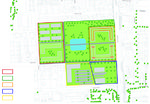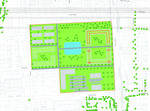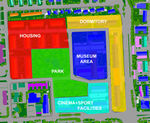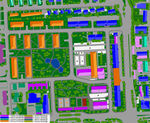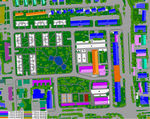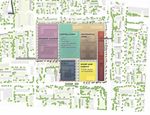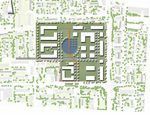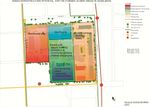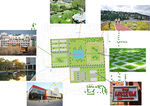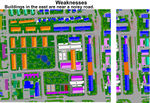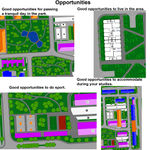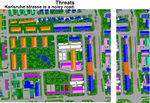Collaborative Green Infrastructure Design Group D
---> back to group page working group D
Green Infrastructure potential for the Former US military hospital in Heidelberg, Germany
| Name | Conversion zone: Former US military territories/US Hospital | |
| Location | add location | |
| Country | Germany | |
| Authors | Erika Jureviciute, Marklen Nakuci, Teodora Koos-Morar, Tabea Crecelius | |

| ||
|
| ||
Landscape and/or urban context of your case
Heidelberg is a town situated on the River Neckar in south-west Germany. The fifth-largest town in the State of Baden-Württemberg after Stuttgart, Karlsruhe, Mannheim and Freiburg im Breisgau, Heidelberg is part of the densely populated Rhine-Neckar Metropolitan Region. Heidelberg is in the Rhine Rift Valley, on the left bank of the lower part of the River Neckar in a steep valley in the Odenwald. It is bordered by the Königsstuhl (568 m) and the Gaisberg (375 m) mountains. The River Neckar here flows in an east-west direction. Since Heidelberg is among the warmest regions of Germany, plants atypical of the central-European climate flourish there, including almond and fig trees; there is also an olive tree in Gaisbergstraße.
The US Hospital is located in the south of Rohrbach at the Karlsruhe street. It was the hospital for the army people and their families living in Heidelberg, Mannheim, Worms and Karlsruhe. The US Hospital is the smallest conversion area in Heidelberg for redevelopment having only 1,8 ha built up. The basic structure and functionallity of the buildings are mostly directed with the hospital operations. Two buildings on the east, the former sporthall and theater are buildings to be conserved. The area is very easilly accessible with the individual and public transport. Currently the area is accessible from Karlsruhe, Freiburger and Kolbenzeil streets.
- Maps
What are the overall objectives of your design? What are the specific objectives for enhancing green infrastrucutre?
Currently the area is a dead zone. Nobody is allowed to enter in it. The buildings are in bad shape needing demolition and improvement interventions. Considering these issues, the main objective is to turn the area in a vital zone that will serve the city and its residents. The interventions and the changes should be done according Green Infrastructure principles. Therefore connectivity, multi-functionality and sustainability are the 3 main goals. New roads will penetrate the zone in order to connect and integrate it with the city. Thus this zone will not be anymore an island in the city but will be part of it. The area contains historic values that need to be retained and reinforced. To keep the cultural heritage of this areas we propose to transform one of the buildings into a museum and some of the buildings will be adapted to contain new functions. Functions like dormitory, housing, cinema, sport facilities, museum connected through green areas will characterize the zone in order to fulfill the multi-functionality aspect of Green Infrastructure. The green spaces and the park that we propose in the zone will create a sustainable environment.
Analytical drawings
- Analytical Drawings
Projective drawings
- Projective Drawings
Design Synthesis
- Design Synthesis Drawings
Summary of the collaborative process
In a collaborative design process you need to consider and respect different point of views, different meanings and different approaches. The common design is characterized through the ability to find a compromise, which is working for everybody in the group. The potentials come from the experiences of the group members, their creativity, their educational, professional and cultural backgrounds, their approaches and their focus on certain aspects. For example in this group we had an architect, a landscape designer with a master in sustainable development engineering, a landscape architect and a landscape architect and planner. So there was an interesting mixture of subjects and people from four different countries, who brought their knowledge into the design process. In an at large harmonic design process we had only one conflict point referring to the existing buildings in the site, if we demolish them or not. Because the existing buildings are from a US hospital from post-war times we decided to preserve some buildings for a museum to keep the cultural and historical heritage of the site. This example shows what is the great part of a collaborative design process: to find solutions, which were maybe never been found, when each of us worked for himself/ herself.
Image Gallery
- Image Gallery
References
- Garten+Landschaft 01/2015, S.11
- http://www.heidelberg.de/Konversion,Lde/Startseite+Konversion/Konversionsflaechen.html
- http://en.wikipedia.org/wiki/Heidelberg
- http://www.heidelberg.de/site/Heidelberg_ROOT/get/documents/heidelberg/Objektdatenbank/12/PDF/12_pdf_Heidelberg_auf_einen_Blick.pdf
- http://www.theguardian.com/environment/2013/may/04/paris-green-roofs-building-climate-environment
- http://niniane.blogspot.co.at/2011/10/minted-at-caltech-career-fair-on.html
- http://landesblog.de/blog/2014/07/09/schleswig-holstein-entdecken-mit-der-museumscard/
- http://www.garten-haus.at/?+Schaffen+Sie+Versickerungsflaechen+&id=2500%2C5004924%2C%2C%2CY2Q9NzE%3D
- http://www.wedel.de/wirtschaft-branchen/newsdetail/news/volker-klein-expandiert-nach-hamburg.html
- http://www.refinery29.com/55336
- http://upload.wikimedia.org/wikipedia/commons/5/58/Baden-Wuerttemberg_relief_location_map.jpg
- http://de.wikipedia.org/wiki/Deutschland
- http://residenzlimburgerhof.de/region/heidelberg/
- http://angebote.nh-hotels.de/deutschland/heidelberg/neckarwiese/
- http://www.myself.de/tipps-ratgeber/checklisten/checkliste-umzug
- http://www.badische-zeitung.de/suedwest-1/lka-spitzel-spaehte-linke-gruppen-in-heidelberger-uni-aus--39176105.html
- https://www.google.at/maps/place/Heidelberg,+Deutschland/@49.4057284,8.6836142,18606m/data=!3m2!1e3!4b1!4m2!3m1!1s0x4797c1050eccdccd:0xefe6ea0044243ad7
About categories: You can add more categories with this tag: "", add your categories







